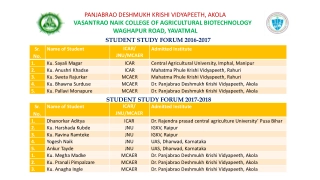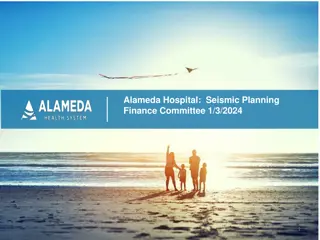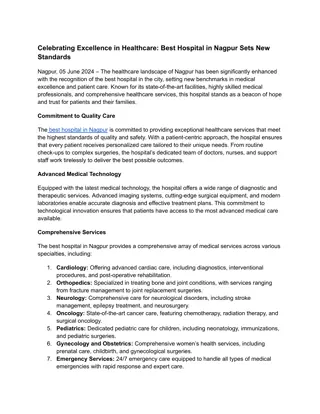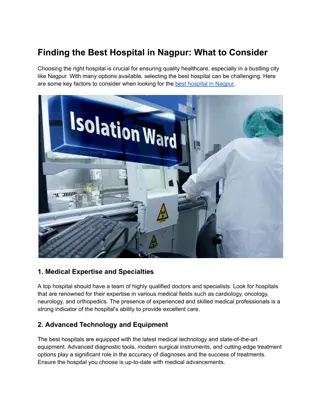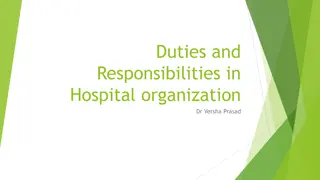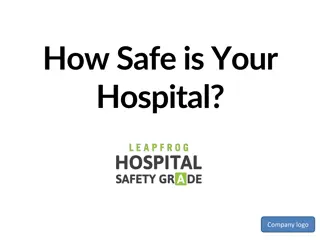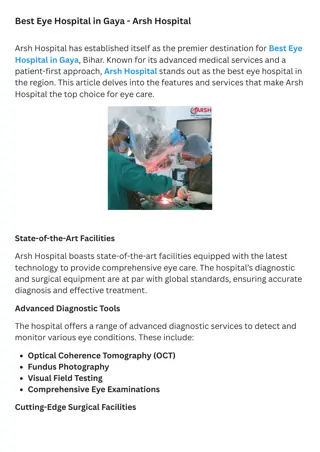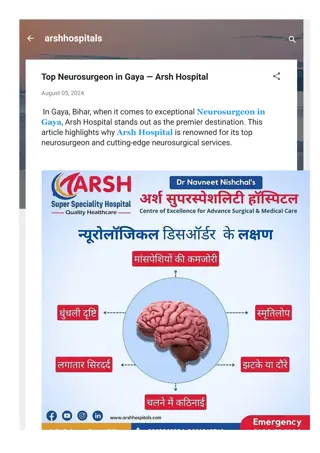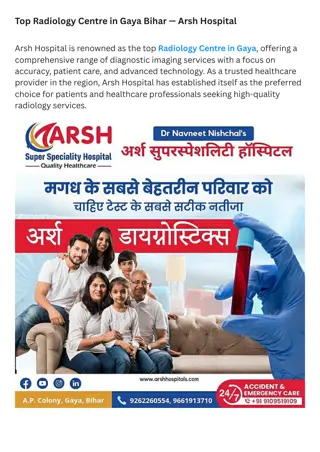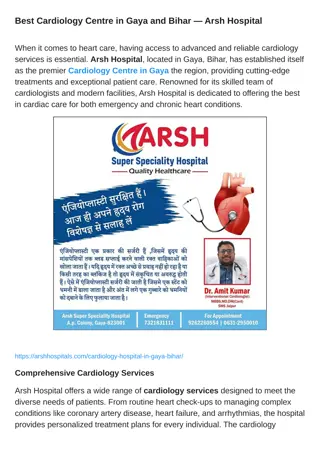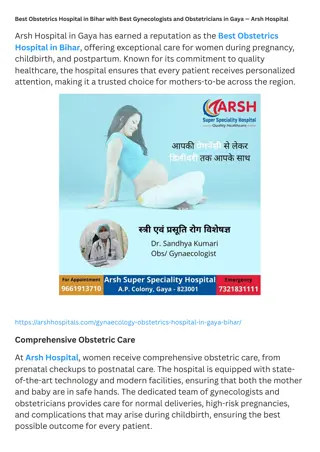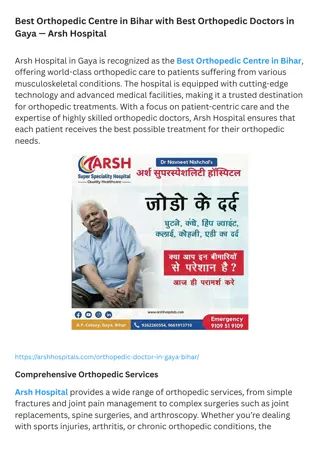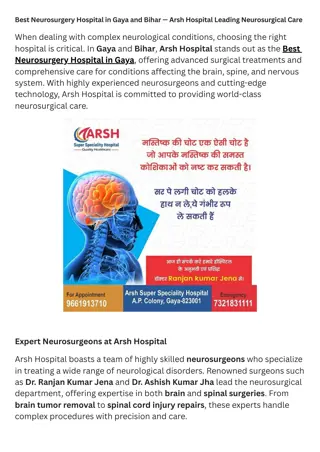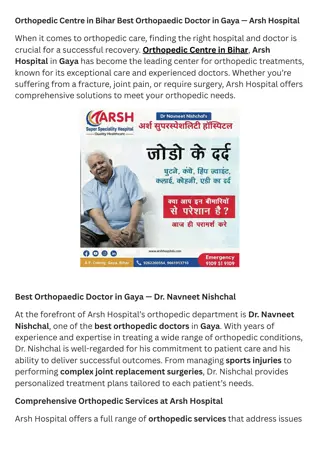
Exploring Ayurvedic Cancer Treatment at Integrated Cancer Center Pune
Discover how Ayurvedic treatment at the Integrated Cancer Treatment and Research Center in Pune, India, is effectively alleviating side effects of radiotherapy in oropharyngeal cancer patients. Learn about the center's innovative approach and its impact on the immune status of the patients.
Download Presentation

Please find below an Image/Link to download the presentation.
The content on the website is provided AS IS for your information and personal use only. It may not be sold, licensed, or shared on other websites without obtaining consent from the author. If you encounter any issues during the download, it is possible that the publisher has removed the file from their server.
You are allowed to download the files provided on this website for personal or commercial use, subject to the condition that they are used lawfully. All files are the property of their respective owners.
The content on the website is provided AS IS for your information and personal use only. It may not be sold, licensed, or shared on other websites without obtaining consent from the author.
E N D
Presentation Transcript
Integrated Cancer Treatment and Research Centre Wagholi, Pune, INDIA Recognized as Center of Excellence by Department of AYUSH, Govt. of India Supported by Department of Atomic Energy (DAE), Government of India Integrated Cancer Treatment and Research Center
Effectiveness of Ayurvedic treatment in alleviating side-effects of radiotherapy in oropharyngeal cancer patients and its relationship with improvement in immune status of the host Vineeta Deshmukh, Sudha Gangal, Arvind Kulkarni, Shubha Chiplunkar*, Shweta Gujar, Trupti Pradhan*, Shriram Agashe, Rupali Gaikwad, Sampat Navale and Sadanand Sardeshmukh Integrated Cancer Treatment and Research Center, Pune, and * Advanced Center for Treatment Research and Education in Cancer (ACTREC), Tata Memorial Center, Navi Mumbai
Introduction Ayurveda, an ancient Indian system of medicine is practised even today for various illnesses especially those which are caused by reduced immune responses Recently combinations of Ayurvedic drugs are recommended for cancer as an adjunct therapy Non-toxicity of Ayurvedic drug combinations makes the drugs acceptable by patients Oral cancer ranks in the top three of all cancers in India with an alarming increase in younger age. High incidence is associated with use of smokeless tobacco The preference of treatment for oropharyngeal cancers is surgery followed by radiotherapy and / or chemotherapy depending upon grade and stage of disease
Introduction Side effects of Radiotherapy often affect immune system and compromise quality of life of cancer patient Side effects are also reflected in Quality of life as the treatment hampers intake of food This major concern is being addressed worldwide We have used selected Ayurvedic medicines, known to act on pathological conditions similar to side-effects of radiotherapy, as per Ayurvedic texts In the first part of this study we have clinically assessed the efficacy of Ayurvedic drugs in alleviating side effects of radiotherapy In the second part, we have assessed the possible improvement in immune status of these patients
Patient population Inclusion criteria: Patients with cancers of all sites in oropharynx, patients of all stages and grades eligible for radiation therapy All patients had undergone surgery before radiation Exclusion criteria: Oral cavity cancer patients who have received palliative radiotherapy, curative chemotherapy along with radiotherapy and those who have undergone Radiotherapy in the past Treatment: Patients received radiation dose up to 6600 cGy in 30-35 fractions in 5-6 weeks First part of the study: Group 1: 35 patients treated with radiotherapy alone Group 2: 35 patients who received combinations of Ayurvedic drugs from the beginning of radiotherapy and continued for 3 months after radiotherapy
Ayurvedic medication for group 2 Ayurvedic medication Mauktikyukta Kamadudha - 250 mg with milk twice a day Mauktikyukta Praval Panchamrut - 250 mg with milk twice a day Ananta Vati - 1 gm with water after both meals Yashtimadhu Ghruta - 5 gm before both meals Yashtimadhu Ghrut - local application in the mouth
Assessment criteria for group 1 and 2 1) Common Toxicity Criteria (CTC, Designed by NIH/NCI) related to symptoms associated with oral cancers : Stomatitis , Trismus, Dysphagia, Xerostomia, Nausea, Excessive salivation and Weight loss - These symptoms were assessed at the end of radiotherapy and 3 months after radiotherapy - Symptoms are grades as 0 (No symptom) to 4 (Severe symptom) as per CTC 2) Karnofsky score 3) QLQ C30 (EORTC European Oraganization of Research and Treatment in Cancer) Quality of Life Questionnaire - Functional, symptom and global score [the later indicating general well-being] Criteria 2 and 3 were assessed before and after radiation All the criteria are internationally accepted outcome measures to assess side-effects and Quality of Life of cancer patients under treatment
Results - symptoms Graphical representation of mean values depicting side effects of radiotherapy Stomatitis P=0.0002 30 25 Trismus P=0.0004 20 Dysphagia P<0.0001 15 10 Xerostomia P=0.0044 5 Excessive salivation Nausea P= 0.0025 Weight Loss 0 Nausea Xerostomia Group 2Group 1 Dysphagia Group 2Group 1 Grade 0 Trismus Weight Loss in % from base line Group 2Group 1 Grade 0 Grade 1 Stomatitis Group 2Group 1 Grade III Grade 1 Grade II Group 2Group 1 Grade IV Grade II Grade III Grade IV Excessive salivation
Graphical representation of mean values (35 samples) depicting Karnofsky score A Before Radiotherapy , B After Radiotherapy 82 80 80 79.14 78 78 76 Karnofsky Score 74 p = 0.0031 72 72 70 68 A B A B Group 2 Group 1
Graphical representation of mean values depicting functional, symptom and global score of QLQ A Before Radiotherapy , B After Radiotherapy 120 97.78 100 84.12 84.5 Functional p value - < 0.0001 80 83.33 58.81 58.81 57.5 60 Global p value - < 0.0001 40.7 32.67 40 24.76 20 19 17.95 Symptom p value - < 0.0011 0 A B A B Group 2 Group 1
Conclusion 1. Ayurvedic treatment is effective in management of Radiotherapy side-effects in oral cavity cancer patients such as stomatitis, trismus, dysphagia, xerostomia and nausea 2. Karnofsky score representing ability to conduct daily activities, as judged by clinician, improved significantly with adjunct Ayurvedic treatment 3. Global score of QLQ indicative of general feeling of wellbeing, as assessed by patient was significantly reduced in group 1 patients while in group 2 patients the feeling of well being did nor worsen as reported by the patients themselves
Part 2 Effect of Ayurvedic medicines on immune response of Oral Squamous cell carcinoma (OSCC) patients: preliminary studies. Relationship of oral Ayurvedic medicines (OAM) used in this study with immune response - a) Rasayana: 4 drugs categorised as Rasayana are used in this study. They are known to boost up immunity as per Ayurvedic texts b) Two drugs used in this study are known to reduce inflammatory responses c) Selective Panchakarma procedures used for side-effects in OSCC include medicated oil treatments, local applications in mouth region and massage meant for systemic and local detoxification. This treatment was given to a group of patients treated with RT and OAM, who continued to show side effects 1 to 6 months post RT
Immunological criteria assessed 1) Immunophenotyping - Total T & B cells and T cells subsets in PBMC and mitogen induced proliferation of T and B cells 2) Markers of tumor load: CD105 and Ki67 3) Assessment of cytokines carried out in saliva and serum, local responses were indicated by salivary samples, therefore data presented will be on salivary samples Type 1 cytokines: IFN- and TNF- Type 2 cytokines: IL-1 , IL-6, IL-8 and IL-10, indicative of inflammatory status 4) Immune complexes and IgA in saliva indicative of local immune response.
Grouping of patients Major limitation of the study: 1. small sample size. Group 1a controls: 1 normal healthy donor, 1 chewer with mild leukoplakia 1 chewer with severe leukoplakia Group 1b OSCC patients treated with RT alone 2 Group 2a OSCC patients treated with RT and OAM 5 Group 2b OSCC patients treated with RT + OAM + Panchakarma -6 2. Large variation in test results in individual samples in 2a and 2b, statistical analysis was therefore not conclusive although pattern of response was same Time point of assessment 2a: A - beginning of RT + OAM, B at the end of RT + OAM, C 1 month post RT + OAM 2b: A beginning of Panchakarma (OAM continued), B at the end of Panchakarma (OAM continued), C 1 month post Panchakarma (OAM continued)
Total CD 3 in PBMC Total CD 4 in PBMC 70 Healthy Mean Healthy Mean 50 45 60 40 50 Control OC Mean Control OC Mean % of Lymphocytes 35 % of Lymphocytes 30 40 25 30 Test Pt Represen tative Test Pt Representati ve 20 15 20 10 Panchaka rma Pt Represen tative 10 5 Panchakarm a Pt Representati ve 0 0 A B C A B C Total CD 8 in PBMC Total CD 19 in PBMC 14 25 Healthy Mean Healthy Mean 12 20 10 Control OC Mean % of Lymphocytes % of Lymphocytes Control OC Mean 15 8 6 Test Pt Represe ntative 10 Test Pt Represent ative 4 5 Panchak arma Pt Represe ntative 2 Panchakar ma Pt Represent ative 0 0 A B C A B C
T Cell Proliferation ( PHA) 80000 Healthy Mean 70000 60000 Control OC Mean 50000 Mean CPM 40000 Test Pt Representative 30000 20000 Panchakarma Pt Representative 10000 0 A B C B Cell Proliferation (PWM) 35000 Healthy Mean 30000 Control OC Mean 25000 Mean CPM 20000 Test Pt Representati ve 15000 10000 Panchakarm a Pt Representati ve 5000 0 A B C
Tumor markers CD 105 in Serum Ki 67 in Serum 4 20 Healthy Mean Healthy Mean 18 3.5 16 3 Control OC Mean Control OC Mean 14 2.5 ng/ml 12 ng/ml 2 10 Test Pt Represen tative Test Pt Represent ative 1.5 8 6 1 Panchaka rma Pt Represen tative Panchaka rma Pt Represent ative 4 0.5 2 0 0 A B C A B C
Local immune response IGA in Saliva IC in Saliva 2.5 140 Healthy Mean Healthy Mean Absorbant OD at 450 Wavelength 2.49 120 2.48 100 Control OC Mean Control OC Mean 2.47 ng/ml 80 2.46 Test Pt Represent ative 60 Test Pt Representa tive 2.45 40 2.44 Panchaka rma Pt Represent ative 2.43 20 Panchakar ma Pt Representa tive 2.42 0 A B C A B C
Type 1 cytokines in saliva IFN gin Saliva TNF a in Saliva Healthy Mean 80 90 Healthy Mean 80 70 70 60 Control OC Mean 60 Control OC Mean 50 50 pg/ml pg/ml 40 Test Pt Represen tative 40 Test Pt Represent ative 30 30 20 20 Panchaka rma Pt Represen tative Panchakar ma Pt Represent ative 10 10 0 0 A B C A B C
Type 2 cytokines in saliva Health y Mean IL 1 in Saliva IL 10 in Saliva 12 140 Healthy Mean 120 10 100 pg/ml 8 80 pg/ml Control OC Mean 60 6 Control OC Mean 40 4 20 0 2 A B C 0 . A B C IL 6 in Saliva IL 8 in Saliva 160 Healt hy Mean Healthy Mean 350 140 300 120 250 Control OC Mean 100 200 pg/ml pg/ml 80 Contr ol OC Mean 150 60 100 Test Pt Represe ntative 40 50 20 0 0 A B C A B C
Tentative conclusion Based on the preliminary data, the trends indicate- 1) Local immune response in saliva shows better association with treatment outcome 2) Immune recovery in the form of a) phenotypes in peripheral blood b) proliferative responses in T and B cells c) oral mucosal immunity d) type 1 cytokines e) reduction in circulating tumour markers is seen in patients treated with oral administration of Ayurvedic drugs along with RT. 3) The pro inflammatory cytokines showed decrease after radiation. In both 2a and 2b patients this response appears to be related to Ayurvedic treatment 4) Type 1 cytokines IFN- and TNF- show low levels initially which are increased in both 2a and 2b after 1 month of radiotherapy, which is perhaps indicative of polarization towards TH1 response Further research leads require inclusion of larger cohort and extended follow-up with OAM to confirm the findings
Controls and TNM classification 1) 4 parameters compared in 3 normal donors Proliferation T IL 10 in Saliva CD 105 in Saliva Name of Group cell CD3 Healthy 65187 35 4.3 1.8 Tobacco chewer with mild leukoplakia Tobacco chewer with severe leukoplakia 33506 29 0.9 3.2 73356 27 1.4 2.1 Mean - Healthy 57350 33 2.2 2.4 2) Responses of T1/T2 Vs T3/T4 patients Stage Mean values Stage I + II 65437 41 2.6 2.5 Stage III + IV 54132 53.8 5.1 2.62

